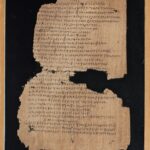| Artefact ID | 758 |
| TM ID | TM 62002 |
| Findspot (DEChriM ID) | - () | Class | Textual |
| Material | Papyrus |
| Writing medium | Codex |
| Text content | Literary |
| Language | Greek |
| Description | P.Beatty VI 11; P.ChesterBeatty VI 11 Four papyrus fragments containing the Old Testament text of Ben Sira, Ecclesiasticus 36-37 and 46-47. The fragments comprise two folios from a codex containing the Ecclesiasticus 36.28-37.11; 37.11-22 (fragment A; an almost complete folio measuring 33 x 20 cm, or 27 x 18 cm according to Van Haelst 1976: 105) and 46.6-11; 46.16-47.2 (fragment B; parts of the lower half of a folio measuring 15 x 8 cm). The text is written in one column, and covers both the recto and the verso of the fragments. The codex is estimated to have contained 54 folios originally, with approx. 35 lines of text per page. Fragment A additionally preserves the pagination which numbers the folio as pages 73 (omicron-gamma) and 74 (omicron-delta). |
| Selection criteria | Literary genre (Biblical) |
| Date from | 300 |
| Date to | 400 |
| Dating criteria | Palaeography. The uncial is placed by the ed. pr. in the 4th c., as reported by Van Haelst 1976: 106. The period is narrowed down to the first half of the 4th c. (see TM-entry) or to the second half of the 4th c.; see online-entry of the Chester Beatty papyrus (provided in the links). |
| Absolute/relative date | Relative date |
| Archaeological context | The provenance of the fragments is uncertain, but they are recorded as part of an acquisition by Sir Chester Beatty in 1930-31. Aphroditopolis (Atfih, by Schmidt), Upper Egypt or Panopolis (by Sanders) and the Arsinoites (Fayûm, by Kilpatrick) are mentioned as a possible provenance; see the overview of Van Haelst 1976: 30. |
| Accession number | Dublin, Chester Beatty Library P.Bibl. 11. |


 Json data
Json data




